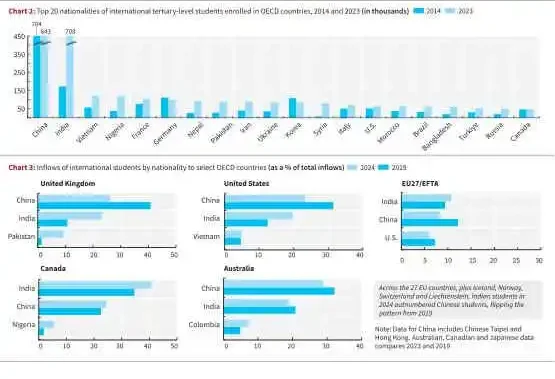International student inflows into major education hubs like the U.K., U.S., Canada, and Australia dropped sharply in 2024, reversing the post-COVID boom. Meanwhile, Europe and East Asian countries are emerging as growing study destinations.
Background
- During the COVID-19 years (2020-21), student mobility declined due to travel restrictions.
- After reopening (2022-23), these traditional hubs witnessed a surge in admissions.
- The sudden rise strained housing markets, public services, and job availability for local citizens.
- As a result, many governments tightened student visa rules in 2024, leading to reduced inflows.

Decline in Traditional Destinations
- U.K., U.S., Canada, Australia witnessed a clear fall in international admissions in 2024.
- Reasons: Housing shortages and rising rents, Pressure on labour markets, Policy tightening on student visas and work permits
Rise of New and Alternate Destinations
- Countries like Germany, France, Spain, Japan, and South Korea saw steady or rising student numbers.
- Reasons:
- Affordable education and lower living costs
- Better post-study work and research opportunities
- Government support to attract skilled global talent
Indian Students Abroad
- Number of Indian students studying overseas rose from 1.72 lakh (2014) to 7.07 lakh (2023) — more than 310% increase.
- Shows rising aspirations for global exposure and better career prospects.
Comparison with Chinese Students
- Chinese students increased only 19% during the same period.
- Shift highlights declining Chinese mobility and rising Indian global presence.
United Kingdom
- Indian student share increased from 11% (2019) to ~22% (2024).
- Chinese share fell from 40% to ~25%.
United States
- Indian student share increased from 11% (2019) to ~22% (2024).
- Chinese share fell from 40% to ~25%.
Canada
- Indian student dominance continued to grow until recent visa tightening.
Australia
- Both Indian and Chinese shares declined due to stricter migration rules.
European Union
- In 2024, Indian students surpassed Chinese students across EU+ countries (27 EU nations + Iceland, Norway, Switzerland, Liechtenstein).
Implications
- For India: Growing skilled diaspora, Boost to global networks and remittances
- For host countries: Talent competition, Policy adjustments to balance education and immigration pressures
Conclusion
A strategic global shift in student mobility is taking place. While traditional English-speaking destinations face policy-driven declines, Europe and East Asia are emerging as new education hubs, driven by affordability, work opportunities, and favourable policies. India is now a leading contributor to global student flows, surpassing China in many regions.
This topic is available in detail on our main website.





